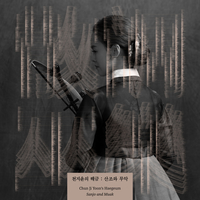앨범 정보
-

- 천지윤의 해금 : 산조와 무악
- 천지윤
- 앨범 평점 3.5/ 7명
- 발매일 : 2020.02.04
- 발매사 : 사운드프레스
- 기획사 : 천지윤
천지윤의 해금 : 산조와 무악
‘지영희류 해금산조’와 ‘경기무악에 의한 해금유희’
1975년 구성된 지영희류 해금 긴산조와 더불어 강렬한 연주를 담은 ‘경기무악에 의한 해금유희’를 통해 경기음악의 DNA를 품은 전통적인 해금소리와 전위적이고 실험적인 해금소리 양 극단을 모두 경험할 수 있다.
이 음반에 수록된 산조는 지영희가 말년에 이르러 집대성한 가락으로 구성된 것으로 다양한 경기가락과 더불어 경기토리의 맛을 풍부하게 지녔기에 유의미하다.
‘경기무악에 의한 해금유희’는 올림채-발뻐드레-도살풀이-도살풀이몰이 등의 장단에 땅과 하늘, 우주와 같은 무한한 것과 유한한 삶 속의 인간과의 대화를 상상하며 연주했다.
이 안에서 즉흥적인 해금가락들을 생성했고 이를 징, 장구 등의 타악기로 황민왕과 김용하가 연주를 도왔다.
곡 해설
1. 경기무악에 의한 해금유희
천지윤 작곡
해금은 경기 굿판에서 자라난 악기다. 굿판에는 굿을 요청하는 이의 삶의 이야기와 더불어 희노애락애오욕 (喜怒哀樂愛惡慾)을 비롯한 감정들이 흘러넘친다.
굿은 인간의 욕망과 발원의 간절한 분출구다. 굿에 수반되는 음악인 무악은 만신을 노래하게 하고 춤추게 한다. 경기무악은 불균등한 장단 형태가 핵심적인 개성으로 손꼽힌다.
3박과 2박이 혼합되어 있는 점도 특징적이고, 하나의 장단을 쪼개고 몰아가다 극한에 이르면 다른 장단으로 넘어가며 새로운 지평이 끊임없이 열린다. 이런 경기무악의 개성을 해금으로 표현해보고자 했다.
올림채-발뻐드레-도살풀이-도살풀이몰이 등의 장단에 땅과 하늘, 우주와 같은 무한한 것과 유한한 삶 속의 인간과의 대화를 상상하며 연주했다.
이 안에서 즉흥적인 해금 가락들을 생성했고 이를 징, 장구 등의 타악기로 황민왕과 김용하가 연주를 도왔다. 2016년 부산국립국악원 [천지윤의 해금 : 경기굿]이라는 제목으로 공연된 실황 음원이다.
2. 지영희류 해금산조 (1975년 지영희 구성)
지영희류 해금산조는 경기무악의 대가였던 지영희(1910-1979)가 구성한 것이다. 지영희는 20세기 한국음악 분야의 입지전적인 인물로 해금, 피리, 장단 등 전통음악 전 분야에 능통했다.
산조는 진양-중모리-중중모리-굿거리-자진모리 등의 장단에 연주자 스스로 가락을 구성하고 즉흥성을 가미하기도 하는 전통을 갖고 있다.
지영희는 10분 내외의 분량으로 다양하게 변주되던 산조 가락과 무속 시나위 가락을 집대성해 1975년, 30분 내외의 긴산조를 유음으로 남겼다.
카세트 테잎 형식으로 전해진 이 유음을 제자인 최태현이 지영희의 유족을 통해 전달받아 이를 채보하여 악보로 발표한 것이 본 음반에 수록된 산조가락이다.
이후 최태현은 지영희 가락을 근간으로 자신의 가락을 첨삭하여 시기별로 여러 버전의 ‘지영희류 해금산조’를 발표했다.
이 음반에 수록된 산조는 지영희가 말년에 이르러 집대성한 가락으로 구성된 것으로 다양한 경기가락과 더불어 경기토리의 맛을 풍부하게 지녔기에 유의미하다.
Chun Ji Yoon‘s Haegeum : Sanjo and Shaman Music
‘Ji Yeoung Hui ryu(style) Haegeum Sanjo’ and ‘Haegeum Play with Gyeonggi-do Province’s Shaman Music’
In this album, you can experience both extremes of traditional Gyeonggi music and the avant-garde and experimental sounds of Haegeum through ‘Ji Yeoung Hui ryu Haegeum Gin(long)-Sanjo’ which was organized in 1975 and ‘Haegeum Play with Gyeonggi-do Province’s Shaman Music’.
The Haegeum Sanjo of this album is composed with a melody from Ji Yeoung Hui’s later years and it has abundant characteristics of Gyeonggi Garak(melody) and Gyeonggi Tori(a specific music style and idiom of the province), so it is very special and meaningful.
The ‘Haegeum Play with Gyeonggi-do Province’s Shaman Music’ piece was performed imagining a conversation with unlimited things like earth, sky, and the universe and the limited life of humans, through the rhythm of Ollimchae-Balppudrae-Dosalpuri-Dosalpurimori.
In this piece, the Haegeum melody was improvised with Korean traditional percussions, Jing and Janggu, which is played with Hwang Min Wang and Kim Yong Ha.
1. Haegeum Play with Gyeonggi-do Province’s Shaman Music (composed by Chun Chun Ji Yoon)
Haegeum is the music instrument which is developed in Gyeonggi-do province’s Gutpan(shaman’s exorcism). The Gutpan is exploded with lots of stories and emotions like happiness, anger, sorrow, joy, love, hate, and greed.
Gut is the exhaust nozzle of human desire and wish. The shaman music which is accompanied with Gut makes a shaman sing and dance. Gyeonggi-do province’s shaman music has the core characteristics of inequable rhythm style and mixtures of triple and duple time as well.
Split the beats, reach the limit and cross to the other beat and open a new prospect constantly. In this album, you can enjoy the very essence of Gyeonggi-do province shaman music through Haegeum.
This piece was played, imagining the conversation with unlimited things like earth, sky, and the universe and the limited life of humans, through the rhythm of Ollimchae-Balppudrae-Dosalpuri-Dosalpurimori.
In this piece, Haegeum melody was improvised with the Korean traditional percussions, Jing and Janggu, which is played with 황민왕 and 김용하.
This is the live sound source which was performed as a title, ‘Chun Ji Yoon’s Haegeum : Gyeonggi Gut’ at Busan National Gugak Center in 2016.
2. Ji Yeoung Hui ryu Haegeum Sanjo (composed by Ji Yeong Hui in 1975)
Ji Yeoung Hui ryu Haegeum Sanjo was organized by Ji Yeong Hui(1910-1979), the master of Gyeonggi Shaman Music.
Ji Yeong Hui is a legendary artist of 20th century Korean Music. She was a master of Haegeum, Piri and dealing with the rhythm as well.
She was proficient over a wide variety of Korean traditional instruments and music.
Sanjo has the tradition that an artist composes and improvises the melody by him or herself, which is based on the rhythm of Jinyang-Jugmori-Jungjungmori-Gutguryri-Jajinmori etc.
Ji Yeong Hui compiled the Sanjo and shaman Shinawai melody which had been played in variation around 10 minutes and left 30 minutes, Gin(long) Sanjo in 1975.
After she passed away, her student 최태현 was delivered the cassette from the family of the deceased, made a score, and released it.
It is a piece which is included in this album. Later, 최태현 presented various versions of ‘Ji Yeong Hui ryu Haegeum Sanjo’ through time, which is based on the Ji Yeong Hui‘s Sanjo but modified with his own style.
Ji Yeoung Hui ryu Haegeum Sanjo in this album is quite a meaningful piece because of its dynamic Gyeonggi melody and rich characteristic of Gyeonggi Tori.
[CREDIT]
1. 경기무악에 의한 해금유희 / Haegeum Play with Gyeonggi-do Province’s Shaman Music
작곡 Compose | 천지윤 Chun Ji Yoon
해금 Haegeum | 천지윤 Chun Ji Yoon
장구 Janggu | 황민왕 Hwang Min Wang
징 Jing | 김용하 Kim Yong Ha
2. 지영희류 해금산조 / Ji Yeoung Hui ryu Haegeum Sanjo
해금 Haegeum | 천지윤 Chun Ji Yoon
장구 Janggu | 김용하 Kim Yong Ha